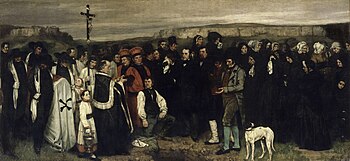Burial at Ornans
| A Burial At Ornans | |
|---|---|
 |
|
| Artist | Gustave Courbet |
| Year | 1849–50 |
| Medium | Oil on canvas |
| Dimensions | 315 cm × 660 cm (124 in × 260 in) |
| Location | Musée d'Orsay, Paris, France |
|
|
A Burial At Ornans (French: Un enterrement à Ornans, also known as A Funeral At Ornans) is a painting of 1849–50 by Gustave Courbet, and one of the major turning points of 19th-century French art. The painting records the funeral in September 1848 of his great-uncle in the painter's birthplace, the small town of Ornans. It treats an ordinary provincial funeral with unflattering realism, and on the giant scale traditionally reserved for the heroic or religious scenes of history painting. Its exhibition at the 1850–51 Paris Salon created an "explosive reaction" and brought Courbet instant fame. It is currently displayed at the Musée d'Orsay in Paris, France.
The Salon found Courbet triumphant with The Stone Breakers, the Peasants of Flagey, and A Burial at Ornans. People who had attended the funeral were used as models for the painting. Previously, models had been used as actors in historical narratives; here Courbet said that he "painted the very people who had been present at the interment, all the townspeople". The result is a realistic presentation of them, and of life, in Ornans.
The painting, which drew both praise and fierce denunciations from critics and the public, is an enormous work, measuring 10 by 22 feet (3.1 by 6.6 metres), depicting a prosaic ritual on a scale which previously would have been reserved for a work of history painting. According to art historian Sarah Faunce, "In Paris the Burial was judged as a work that had thrust itself into the grand tradition of history painting, like an upstart in dirty boots crashing a genteel party, and in terms of that tradition it was of course found wanting." Then too, the painting lacks the sentimental rhetoric that was expected in a genre work: Courbet's mourners make no theatrical gestures of grief, and their faces seem more caricatured than ennobled. The critics accused Courbet of a deliberate pursuit of ugliness. Eventually the public grew more interested in the new Realist approach, and the lavish, decadent fantasy of Romanticism lost popularity. The artist well understood the importance of this painting; Courbet said: "The Burial at Ornans was in reality the burial of Romanticism." It might also be said to be the burial of the hierarchy of genres which had dominated French art since the 17th century.
...
Wikipedia
